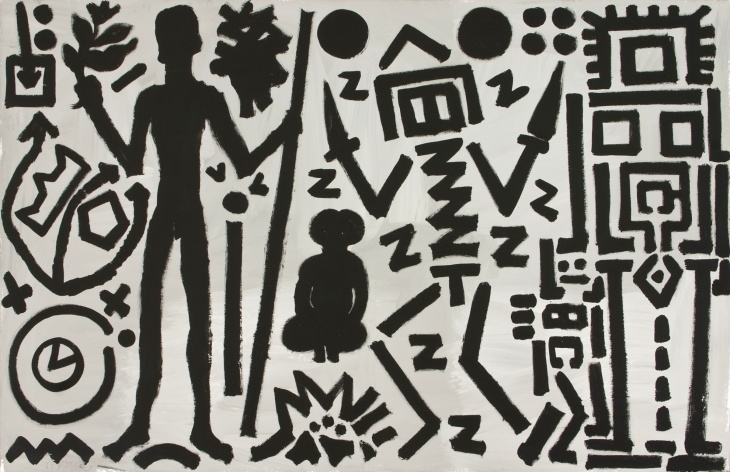Two exhibitions of works by A.R. Penck, one of the most important artists to emerge from Germany during the post-war period. Paintings from the 1980s and Memorial to an Unknown East German Soldier will be presented concurrently from 23 February to 21 April. Featuring several large-scale paintings and a monumental sculpture in wood and bronze, these exhibitions represent a key moment in A.R. Penck’s oeuvre.
A.R. Penck’s life’s work was to create a means of visual expression capable of addressing the entire range of social and political issues facing modern man. He invented a profound and vital pictorial language during a period of bleak social and political division and a looming nuclear threat. Abiding interests in science fiction, cybernetics, and information architecture guided his art toward an investigation of the relationships between man and society’s pervasive systems of power, access and control. A.R. Penck’s primal, reductive imagery and improvisatory execution mask the deep seriousness of his investigations.
Following repeated harassment from the authorities and after many attempts to leave East Germany, A.R. Penck finally managed to emigrate to the West in 1980. His paintings post-emigration are characterized by exuberant colour, a refreshing openness of pictorial space and a focus on working at a monumental scale. Paintings from the 1980s feature a number of major works from this time. A.R. Penck’s renewed interest in sculpture was hastened by access to bronze casting, something unavailable to the artist in East Germany. Whereas in the seventies he began making sculptures with wood, and before that had used perishable materials like cardboard, plastic and aluminium, his access to new materials in the West during the eighties brought sculpture to the fore of his practice, on par with his painting.
“Memorial to an Unknown East German Soldier” is one of A.R. Penck’s most important large-scale sculptures. It was created for the artist’s 1984 exhibition at London’s Tate Gallery and is the artist’s first work in bronze. The sculpture is a symbolic representation of the military ideal of standing and fighting, and dying for a cause. Two identical bronze figures, one standing, the other lying across an altar or table, suggest a sacrificial tableau against which is set a large wooden figure and carved head. Further inspiration came to A.R. Penck from the 5,000-year old burial tomb at Newgrange, Ireland. He described his conception of “Memorial to an Unknown East German Soldier” as a ‘positive’ version of that ancient site and an abstract embodiment of man’s passage from life to death.
| Duration | 23 February 2018 - 21 April 2018 |
| Times | Tuesday through Saturday, 10AM to 6PM |
| Cost | Free |
| Venue | Michael Werner |
| Address | 22 Upper Brook Street, London, W1K 7PZ |
| Contact | 0207 495 6855 / london@michaelwerner.com / www.michaelwerner.com |

